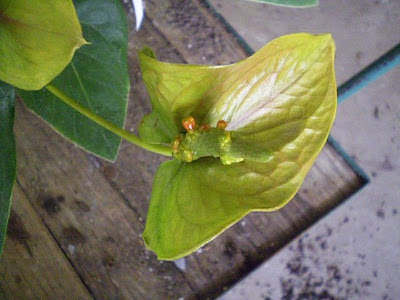My camera is frustratingly unable to capture certain shades of purple accurately. The pictures may be crystal-clear and gorgeous, but all the red always gets sucked out of the purple. It's actually kind of a problem. Adding red with Irfanview doesn't help, because the red also gets added to everything else: it's no use getting the flower the right color if the clouds are pink and the leaves are yellow. It's frustrating, but I soldier bravely onward..jpg)
There are some plants that people seem to love to hate. Garlic mustard (Alliaria petiolata), or perhaps kudzu (Pueraria lobata), for example. Queen Anne's lace seems to be sort of the opposite: it's the plant people kind of hate to love. It's not particularly practical -- you can't really eat it or make baskets out of it or repel insects with it -- but it is, undeniably, pretty in that Julia set kind of fractally way, and that appears to be enough.
We don't actually sell this at work, but I felt the post needed another picture, so it got in. (I'm actually a little surprised we don't; it wouldn't be our first invasive plant, see next picture.)
.jpg)
This one actually disturbs me a little bit. We do sell water hyacinth, despite the fact that it's a known invasive and is very disruptive in the ecosystems to which it's been introduced (via blocking light from deeper water, starving the water of oxygen, displacing native plants, and so forth). Granted that it wouldn't be invasive here, since it's not able to survive freezes (though I haven't seen it definitely stated that the seeds, which are plentiful, couldn't overwinter), but it's not like a fair amount of damage couldn't be done in a single season, too, under the right circumstances. On the other hand, the flowers are quite pretty. There's a weird peacock sort of quality to the top petal that intrigues me.
.jpg)
I actively dislike Angelonia, for unfair reasons. Our entire stock (four or five different varieties) got a bad spider mite infestation toward the end of the spring and couldn't really be snapped out of it, so we had to throw it out. Or at least we wound up throwing most of it out; I think the plant in this picture is one that we managed to salvage. It's an attractive plant when it's healthy, but it goes downhill so fast.
.jpg)
This one's nice. I'm not really a fan of any of the millions of different Salvia smells, but this one is less offensive than most, and the blooms are a genuinely pretty color, and seem to last for a long time. So it's not so bad.
.jpg)
This is the most shameful example of the camera not giving me the right color when it comes to blues and purples. The real thing is both darker and redder. I've not actually spent much time dealing with, or noticing, the Delphiniums, until the last couple weeks, so I don't have much to add to that. I suppose I could say that I like the word. Delphinium. It's nice.





.jpg)
.jpg)
2.jpg)
3.jpg)
.jpg)
.jpg)
.jpg)
.jpg)
2.jpg)
.jpg)
.jpg)
.jpg)





